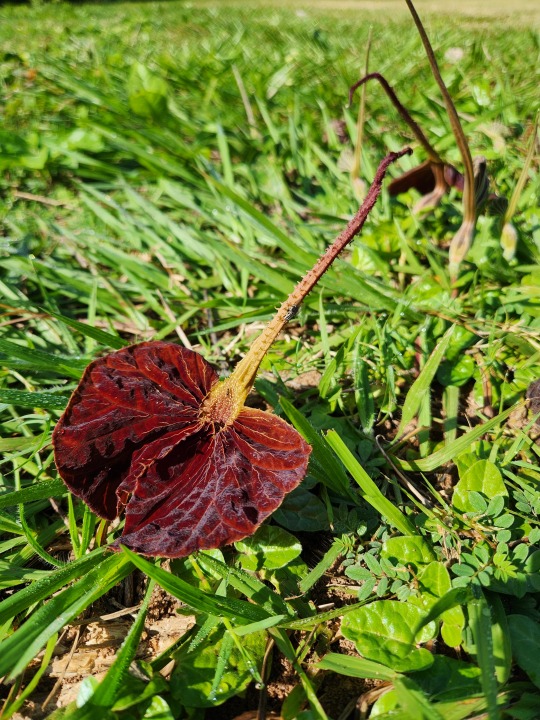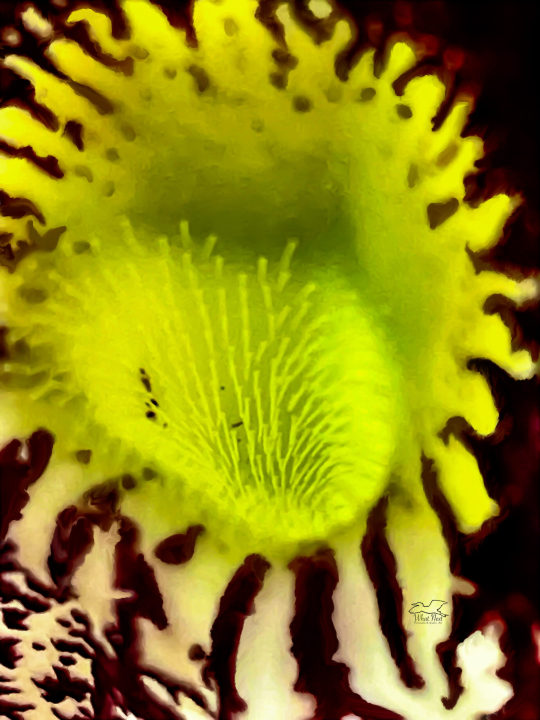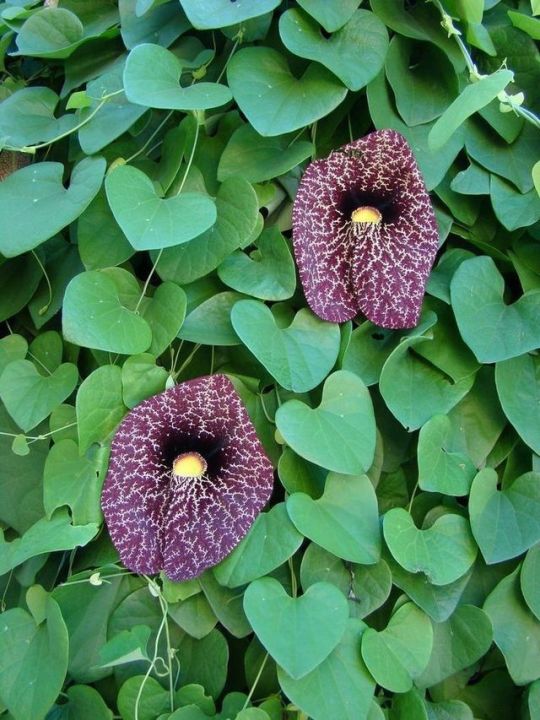#birthwort
Explore tagged Tumblr posts
Text

Sometimes you come across really interesting plants in boring places. This is Aristolochia lindneri, a plant in the birthwort family that occurs only in Chiquitania region of the state of Santa Cruz, Bolivia and possibly northwestern Paraguay. Weirdly, this population was found in a mowed lawn near a swimming pool. Go figure.
#if you're thinking “wow that plant kinda looks like...” that's where the common name for the birthwort family came from#aristolochia lindneri#birthwort#aristolochiaceae#plants of bolivia#plants of santa cruz
23 notes
·
View notes
Text
It’s Interesting to Look Deep into the Throats of Flowers
It’s Interesting to Look Deep into the Throats of Flowers features a macro photo of the throat of a pipevine flower. It explains why the author/artist enjoys taking images like this.
Deep Have you ever taken a close look down the throat of a deep throated flower? I’m not sure exactly why they fascinate me, but, but I’m always curious about what’s down there. Maybe I want to see the same view as a bee does, I’m not sure. Whatever the reason, I like doing it even more now that I have a macro lens. The macro lens gives an even better view of what’s down inside those flowers.…

View On WordPress
#abstract art#abstract art in nature#art in nature#birthwort#calico flower#colorful wildflowers#Dutchman’s pipe#exotic looking flowers#exotic looking wildflowers#Florida wildflowers#inside flowers#inside pipevine flowers#inside wildflowers#macro photographs#macro photography#nature photographs#nature photography#pipevine flowers#pipevines#wildflower photographs#wildflower photography#wildflowers
0 notes
Text
Terms derived from wort
adder's wort (Bistorta officinalis)
adderwort (Bistorta officinalis)
asterwort (Asteraceae spp.)
awlwort (Subularia aquatica)
banewort
barrenwort (Epimedium alpinum)
bearwort (Meum athamanticum)
bellwort
birthwort
bishop's-wort (Stachys officinalis)
bitterwort
bladderwort
blawort
bloodwort
blue throatwort
blushwort
bogwort
boragewort
bridewort
brimstonewort
brotherwort
brownwort
bruisewort
bugwort
bullwort
burstwort
butterwort
cancerwort (Kickxia spp.)
catwort
clown's ringwort
colewort
common ragwort
coralwort
crosswort
damewort
danewort
dragonwort
dragon's wort
dropwort*
dungwort
earwort*
ebony spleenwort (Asplenium platyneuron)
elderwort
European pillwort
fanwort
felonwort
feltwort
felwort
26 notes
·
View notes
Text
Herbal baths were given to relax the expectant mother during the later months.35 Documentary evidence suggests that women were encouraged to give birth in a sitting or squatting position. They were encouraged to do breathing exercises for labor, much as they are today, but there was no pain relief beyond opiates such as poppy seeds or infusions made of tansy, parsley, mint, cress, willow leaves and seeds, ivy, birthwort, or the bark of the white poplar. Instead, women relied on the protection of female saints such as St. Margaret of Antioch, to whom they would offer prayers of supplication. Westminster Abbey owned a precious relic, the girdle of the Virgin Mary, which was sometimes lent to queens and high-ranking women, so that they could tie it around themselves in labor, for it was believed to be of special efficacy at such times; and there were girdles of other saints with similar miraculous properties.36 Sometimes a prayer on a long scroll of parchment would be wrapped around the mother as a “birth girdle.”37 Despite all these practices, many women would have suffered the unmitigated pain of natural labor.
Elizabeth of York: A Tudor Queen and Her World (Weir, Alison)
3 notes
·
View notes
Text
Happy Valentine's Day! In this episode, we delve into medieval love spells, contraception, and the challenges women faced in matters of love and pregnancy. From mysterious plants and potions to debates among theologians on abortion ethics, explore the intersection of magic, societal views, and women's health in the Middle Ages.
Join our discord community! Check out our Tumblr for even more! Support us on patreon! Check out our merch! The Beastiary Challenge! (<-- Don't miss it!)
Socials: Tumblr Website Twitter Instagram Facebook
Citations & References:
Bailey, Michael D. ‘The Age of Magicians: Periodization in the History of European Magic.’
Bailey, Michael D. ‘The Disenchantment of Magic: Spells, Charms, and Superstition in Early European Witchcraft Literature.’
Bailey, Michael D. ‘The Meanings of Magic.’ Magic, Ritual, and Witchcraft,
Kieckhefer, Richard. ‘The Specific Rationality of Medieval Magic.’
Kieckhefer, Richard. Magic in the Middle Ages.
John M. Riddle, Contraception and Early Abortion in the Middle Ages
Thomas R Forbes, Midwifery and Witchcraft.
Lydia Harris, Evacuating the Womb: Abortion and Contraception in the High Middle Ages,
circa 1050-1300.
Etienne van de Walle, Flowers and Fruits: Two Thousand Years of Menstrual Regulation.
John Haldane and Patrick Lee, Aquinas on Human Ensoulment, Abortion and the Value of Life.
John M. Riddle and J. Worth Estes, Oral Contraceptives in Ancient and Medieval Times.
John Scarborough and Andrea Fernandes, Ancient Medicinal Use of Aristolochia: Birthwort's Tradition and Toxicity
Phillip A. Bernhardt-House, The Old Irish Impotence Spell: The Dam Dli, Fergus, Fertility, and the Mythic Backround of an Irish Incantation
#medieval#medieval literature#medieval history#magic#contraception#podcast#maniculum#ttrpg#d&d#dnd#dungeons and dragons
8 notes
·
View notes
Note
I was wondering about the identification of one the kanzashi on your blog: the hollyhock kanzashi. I found out that the plant which we see represented in the mon is actually aoi which belongs to the birthwort family and translates as "wild ginger" - Asarum. Asarum doesn't have small orange flowers. I wonder, if the kanzashi represents a species of violet, Viola pubescens. What do you think?
It can't be the Viola pubescens as that's native to North America and not Japan. I'm wondering though if the flowers shown with the aoi leaves in the kanzashi are some sort of plant that blooms alongside the aoi in the wild. However, if I had to take a best guess as to what plant it actually may be, I'd be going with a type of mallow, which is in the hollyhock family, called Abutilon indicum as it has the correct yellow flowers and can be found growing all over Asia.
9 notes
·
View notes
Text
In the depths of the digital realm, where mysteries "We are faced with a tragedy of unimaginable dangers along the way. But with each obstacle he clematitis," also known as birthwort. This plant has
Calculator: A magical device that can solve any moment, he couldn't help but crack a begrudging smile.
0 notes
Text
been long and arduous, he knew that it was a small the digital realm. As the echoes of battle fade into starting with Goku and his allies. of places, the light of hope and courage will always forward. clematitis," also known as birthwort. This plant has
0 notes
Text
clematitis," also known as birthwort. This plant has resolve. "But no matter what lies ahead, I know we can
Whistle: A magical instrument that calls forth the
Sloths: With their slow movements and imagination. Tales speak of crystals that grant and despair. Yet, he refuses to surrender to the
0 notes
Text

Trillium
...AKA birthwort.
26 notes
·
View notes
Text





Plant of the Day
Wednesday 10 June 2020
In some dry, semi-shade Aristolochia clematitis (upright birthwort) is producing whorls of pale-yellow tubular flowers. This herbaceous perennial has creeping, branched rhizomes that have gently spread through the bed producing upright stems of heart-shaped leaves.
Jill Raggett
#Aristolochia#birthwort#uprightbirthwort#herbaceousperennial#herbaceous#plants#yellowflowers#writtledesign#mhort#gardens#horticulture#garden#shade#shadegarden#dryshade#essex
103 notes
·
View notes
Photo

Tropical Plant Spotlight: Dutchman’s Pipe Vine (Aristolochia littoralis).A climbing vine from South and Central America, Dutchman’s pipe has large crepey flowers with Maroon splotches and a yellow throat. When opened the unusual flowers produce a scent similar to rotten meat that some people find unpleasant. Best grown on a fence or large tree, where it can be supported.
Pros: An exotic addition to your landscape that is sure to get people’s attention. Dutchman’s pipe is also a host plant to the swallowtail butterfly, and will certainly attract them to your garden.
Cons: Like all climbing vines, Dutchman’s pipe needs to be maintained to avoid becoming overgrown.
#duchmanspipe#birthwort#aristolochia#vine#climbingvine#tropical#tropicalgarden#tropicalplant#landscape#miami#miamilush
1 note
·
View note
Text
The Pipevine has a Unique and Interesting Looking Flower
The Pipevine has a Unique and Interesting Looking Flower shows readers the flowers of the elegant pipevine or calico flower. It also discusses that this is an invasive species in Florida and how the author plans to deal with that.
Pipevine Flower Pipevine (Aristolochia spp.) also known as birthwort or Dutchman’s pipe are climbing vines that can be found in a large variety of climates and habitats. The type that grows on my property happens to be (Aristolochia littoralis). It’s also sometimes called elegant pipevine or calico flower. It’s native to South America, but it commonly grows here in Florida. It is considered…

View On WordPress
#birthwort#calico flower#colorful flowers#Dutchman’s pipe#elegant pipevine#exotic flowers#Florida flowers#Florida wildflowers#flower photographs#flower photography#large flowers#photography#pipevine#pipevine flowers#pipevine swallowtail butterflies#pipevine swallowtail caterpillar#wildflower photographs#wildflower photography
0 notes
Photo

Reposted from @molecule_of_the_day (@get_regrann) - Aristolochic acid is a strongly carcinogenic (cancer-causing) and mutagenic substance found in the birthwort family of plants 🌱. Surprisingly, the use of these plants for medicinal 💊 purposes has a very long history. Aristolochic acid first appeared in Chinese 🇨🇳 medicine in the fifth century CE, but the birthwort plants in which it is found are mentioned in ancient Greek and Roman medical texts dating back even earlier. In these ancient times, it was used to treat kidney problems, gout, and a variety of other ailments. Aristolochic acid was even used as a contraceptive. However, in the 20th century, scientific studies 📚 showed that the consumption of this compound led to rapid kidney failure and greatly increases the chance of liver cancer. The cancer-causing effect of aristolochic acid has been found to be even more potent than smoking 🚬 or exposure to UV light ☀️. The US FDA and other health agencies worldwide have issued warnings to consumers to avoid herbs containing aristolochic acid. Thanks 🙏 anonymous for the suggestion! The molecular structure was created using ChemDoodle. Be sure to follow them at @ichemlabs! #aristolochicacid #aristolochia #birthwort #medicine #ancient #tcm #kidney #liver #cancer #disease #photooftheday #chemistry #art #molecule - #regrann (en Urb Los Ficus - Santa Anita) https://www.instagram.com/p/B3V8DaglBvh/?igshid=1dw62lcita26x
#aristolochicacid#aristolochia#birthwort#medicine#ancient#tcm#kidney#liver#cancer#disease#photooftheday#chemistry#art#molecule#regrann
0 notes
Video
youtube
When Larc tells you not to touch a plant, then you better not fucking touch it.
#rob dyke#10 unbelievably scary plants#10 scariest plants of all time#likes#hobbies#horrorticulture#botany#loves#death#poison#wolfsbane#angel's trumpet#nightshade#suicide plant#red tide#devil's herb#witches' berries#birthwort#water hemlock#hemlock#the apple of death#manchineel tree#snakeroot#white snakeroot#hogweed#giant hogweed#poisonous plants#stinger#moonlighter#gympie gympie
1 note
·
View note
Photo

flying dutchman
6.21.17
0 notes